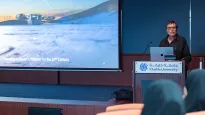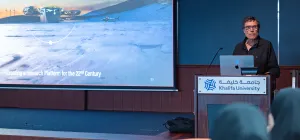Field Research Projects at the Princess Elisabeth Antarctica

For those interested in polar science, we’re providing a brief overview of the many scientific research projects taking place at or in the vicinity of the Princess Elisabeth Antarctica station during the 2018-2019 season.
This year, researchers from Belgium, the United Kingdom, Switzerland, Germany, Hungary, Norway, Turkey, and Japan are spending time at the station. Between all of them, they’re working on research projects in the fields of glaciology, atmospheric sciences, microbiology, geology, and geomagnetism.
As there are so many research projects taking place this season, we’ll first provide an overview of the ones in which scientists and those assisting them are actively taking samples or collecting data in the field this season. Of the 17 research projects happening this season at the station, 11 include active field research and data collection (with assistance from the professional team of field guides and mechanics from the International Polar Foundation).
- BioFe in Glacial Systems
Since the first young resarcher was awarded the prize in 2008, the Princess Elisabeth Antarctica has hosted the laureate of the Baillet-Latour Antarctica Fellowship every season. During this year’s research season as well as next year’s, the 2018-2020 laureate, Dr. Kate Winter from Northumbria University, will use the €150,000 in prize money to conduct research for the BioFe in Glacial Systems project. BioFe is looking at how nutrients in the detritus in ice flowing off the Antarctic Ice Sheet contributes to carbon dioxide uptake by phytoplankton and other primary producers (photosynthetic microscopic organisms) in the Southern Ocean. Dr. Winter and a colleague are spending six weeks at the station in December and January to conduct ground penetrating radar soundings and aerial drone scans to get a clear view of the ice and landmass in the area they area studying.
- CHASE
A collaboration between researchers from the Royal Meteorological Institute of Belgium (KMI/IRM), Ghent University (UGent), the Universtié Libre de Bruxelles (ULB) and the Vrij Universiteit Brussel (VUB), the CHASE project aims to build a unique database of organic and inorganic particles in the atmosphere and on the surface of the snow in the region around the Princess Elisabeth station. Two researchers spent just over a month at the station in November and December taking atmospheric measurements. Station engineer Benoît Verdin will continue to perform maintenance on the instruments in the project that take measurements until the end of the season.
- Mass2Ant
The MASS2ANT project continues the efforts of researchers from the Université Libre de Bruxelles (ULB) led by Prof. Jean-Louis Tison to better understand the variability in the surface mass balance of ice cover in East Antarctica. In order to do this, a team of seven researchers have been taking ice cores from a series of ice rises at or near the King Baudoin Ice Shelf at the coast, about 200 km from the station. The ice cores will be transported back to Brussels where they will be analysed and reveal clues about variation in ice mass balance in the region over time. You can relive their adventures on the project blog.
- Kirklareli University survey
Kirklareli University in Turkey has sent a researcher for just over a month in December and January to survey the Sør Rondane Mountains (which are not far from the station) in preparation for a potential expedition to hunt for meteorites next year. Meteorites found in Antarctica are the best preserved in the world, and can give clues as to the origins and development of our solar system. Belgian geologists, who have hunted for meteorites with Japanese scientists during past BELARE missions, are also following the developments of the mission.
- DEAIS
A researcher from the University of Bern in Switzerland will remain at the station for a month and a half (mid-December to the end of January) to do some work for the DEAIS project, which hopes to reconstruct past ice sheet coverage in Antarctica using a technique known as cosmogenic sampling. Understanding past ice sheet coverage can help scientists predict how the Antarctic Ice Sheet might react to climate change.
- MICROBIAN
Three researchers from Ghent University and Liège University Belgium will arrive at the station in late January to spend a month doing field work for the MICROBIAN project, which is mapping microbial life in the ice-free areas of the Sør Rondane Mountains near the station. During their visit to Antarctica, researchers will take some samples, do some maintenance of monitoring equipment that had been installed during previous field work, and use drones to make high-resolution maps of areas of interest in Sør Rondane Mountains.
- GEOMAG
Two researchers from the Royal Observatory of Belgium (KMI / IRM) will take measurements and install a series of instruments at the King Baudoin Ice Shelf at the coast as part of the GEOMAG project. During their time at the station, the researchers will also do maintenance on the geomagnetic observatory that was set up in a shelter next to the Princess Elisabeth station.
- From Clouds to Ground & LOSUMEA
A joint effort undertaken under the leadership of Prof. Michael Lehning from the WSL Institute for Snow and Avalanche Research (SLF) and the CRYOS lab at the Polytechnic School of Lausanne (EPFL) in Switzerland are studying connections between snow deposition and surface mass balance of ice in East Antarctica. This season, one scientist at the Princess Elisabeth station and one at the Japan's Showa station nearby are tasked with maintainting monitoring equipment under the "From Clouds to Ground: Snow Deposition in Extreme Environment" and LOSUMEA projects. These connected projects have the ambitious goal to clarify the relationship between precipitation, drifting and blowing snow, and ice formation. Since 2016, the projects have been collecting data from a number of instruments set up in a few locations around the Princess Elisabeth station.
- LGGE Transect
Before leaving Antarctica, IPF President and BELARE Team Leader Alain Hubert will continue his commitment for more than a decade to taking snow depth measurements for the Glaciology Laboratory at the University of Grenoble Alpes in France along the same transect between Crown Bay at the coast and Vesthaugen Nunatak. This year glaciologist Jean Rasson from the Royal Meteorological Institute of Belgium (KMI / IRM) will accompany Alain on the 180-km trek.
- Beyond EPICA
BELARE team members have also been assisting an international group of researchers taking part in the Beyond EPICA project on their way to and from Dome Fuji on the Antarctic Plateau. This research project hopes to eventually drill an ice core at Dome Fuji, which many scientists believe might contain some ice that is 1.5 million years old and would contain clues to Antarctica’s climate at the time of its formation.
- POLAR 6 Surveys
Every year since the 2011-2012 research season, scientists from the Alfred Wegener Institute (AWI) in Germany have been using the Princess Elisabeth station as a base to conduct observation flights over East Antarctica in their Polar 6 aircraft to conduct aerial surveys. The team is in East Antarctica to take radar profiles of the ice along transects at the coast and on the Antarctic plateau to study the thickness and density of both the land ice and the ice over water on the ice shelves at the coast. Monitoring changes in ice thickness is important to understanding how the continent’s ice mass balance is changing in light of climate change.
A closer look
In the coming weeks, we’ll look at some of the research projects in greater detail and learn how each of them is contributing to increasing humanity’s knowledge about climate change, Antarctica, and how the Earth System functions. So stay tuned!
Download





















